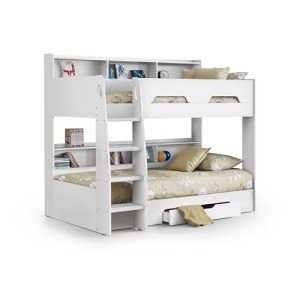Bunk Beds for Kids: A Comprehensive Guide
Bunk beds have been a popular option for children's bed rooms for several years. They offer a space-saving option that makes the most of floor location, offers fun climbing up alternatives, and is available in a range of designs that interest kids's imaginations. This post explores the benefits, factors to consider, styles, and security features associated with bunk beds for kids.
Benefits of Bunk Beds
Bunk beds present multiple advantages that make them an attractive option for families. Here are some crucial advantages:
Space Saving
- Bunk beds permit 2 or more children to share a room without sacrificing space for play or other activities.
Economical
- Acquiring a single bunk bed can be more cost-effective than buying two different beds.
Enjoyable Factor
- Kids often see bunk beds as a fun place to sleep and play, cultivating a sense of adventure.
Flexibility
- Bunk beds are readily available in various setups, consisting of L-shaped, loft beds, and even convertible styles that can alter as children grow.
Organization
- Many bunk beds include built-in storage alternatives, such as shelves and drawers, assisting keep rooms organized.
Secret Considerations Before Purchasing
Before buying a bunk bed, it's necessary to think about certain factors, such as:
- Space Requirements
Procedure the room to make sure that there is adequate vertical space, enabling appropriate headroom on the leading bunk. - Age of Your Children
Consider their age and maturity. Lots of manufacturers suggest that children under 6 should not oversleep the leading bunk due to security issues. - Weight Limit
It's important to check the weight limits of the bunk bed for both the leading and bottom bunks to guarantee security. - Style Preferences
Choose a design that matches the space's decor and the children's preferences. - Product
Bunk beds are readily available in numerous products, such as wood or metal. Each has its advantages and downsides regarding resilience and looks.
Styles of Bunk Beds
Bunk beds come in different designs to fit different aesthetics and functional needs. Here's a list of some popular designs:
- Standard Bunk Beds
Traditional stacked beds that consist of two beds constructed one above the other. - Loft Beds
A bed raised high off the ground, with space below for a desk, play area, or storage. - L-Shaped Bunk Beds
Two beds organized in an L-shape, supplying more floor space and a distinct style element. - Twin Over Full Bunk Beds
These alternatives include a twin bed on leading and a full-sized bed on the bottom, accommodating older children or adults. - Triple Bunk Beds
Developed for 3 kids, these beds usually consist of three stacked beds, suitable for bigger households.
Safety Features to Consider
Guaranteeing the security of children using bunk beds is paramount. Here are some security features to search for before making a purchase:
- Guardrails
A bunk bed need to consist of durable guardrails on the leading bunk to avoid accidental falls. - Ladders
Make sure that the ladder is firmly connected and simple for kids to browse securely. - Stability
Search for bunk beds with lower center of mass and broad bases to offer much better stability. - Quality Construction
Pick beds made from resilient materials that satisfy safety requirements, such as ASTM (American Society for Testing and Materials) guidelines.
Frequently Asked Questions About Bunk Beds
1. What age is suitable for a top bunk?Generally, kids aged 6 and older are recommended for oversleeping the top bunk. 2. Are bunk Bunk Bed UK carolinegonzales.top for toddlers?Most specialists advise versus
putting young children in the top bunk due to the
danger of falls and improper ladder usage. 3. Can bunk beds be separated?Many bunk beds are designed to be separated into 2 standalone beds,
offering included versatility as kids grow
. 4. How do I keep a bunk bed?Regularly check for loose screws and use, keep bed mattress tidy, and guarantee that the bunk bed is
steady to lengthen its life expectancy. 5.
Are there any unique bed mattress requirements for bunk beds?Yes, bed mattress for bunk beds should fit snugly without leaving gaps. Usually, thinner bed mattress
(around 6 to 8 inches )are advised for top bunks for safety. Bunk beds provide a versatile, practical, and enjoyable solution for kids's sleeping plans, maximizing space while accommodating multiple kids in one room. By thinking about the important elements
of design, security, and space, parents can make an informed decision when selecting the ideal bunk bed for their kids's requirements. With the right care and maintenance, a bunk bed can be a cherished piece of furnishings that provides years of usage and satisfaction for kids. Summary Table of Bunk Bed Styles Style Description Best For Standard Bunk Beds Traditional style, 2 stacked beds Smaller rooms Loft Beds Raised bed with open space below Research study or play areas L-Shaped Bunk Beds 2 beds in an L-shape
Included floor space Twin Over Full Twin on top,
| complete on bottom Accommodating older kids Triple | ||||||
|---|---|---|---|---|---|---|
| Bunk Beds | 3 stacked beds | Larger families By comprehending | the different choices readily available, designated factors to consider for safety and performance, and appropriate age standards, households | can choose the perfect bunk bed that not | just improves their living space | but likewise makes sure a safe and |
| satisfying sleeping environment | for their children.

|
